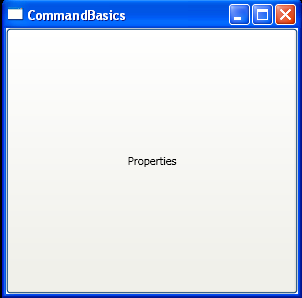<Window x:Class="WpfApplication1.Window1"
xmlns="http://schemas.microsoft.com/winfx/2006/xaml/presentation"
xmlns:x="http://schemas.microsoft.com/winfx/2006/xaml"
Title="CommandBasics" Height="300" Width="300">
<Grid>
<Button Command="ApplicationCommands.Properties" Content="_Properties"/>
</Grid>
</Window>
//File:Window.xaml.cs
using System;
using System.Collections.Generic;
using System.Text;
using System.Windows;
using System.Windows.Controls;
using System.Windows.Data;
using System.Windows.Documents;
using System.Windows.Input;
using System.Windows.Media;
using System.Windows.Media.Imaging;
using System.Windows.Shapes;
namespace WpfApplication1
{
public partial class Window1 : Window
{
public Window1()
{
InitializeComponent();
InputBinding ib = new InputBinding(ApplicationCommands.Properties,new KeyGesture(Key.Enter, ModifierKeys.Alt));
this.InputBindings.Add(ib);
CommandBinding cb = new CommandBinding(ApplicationCommands.Properties);
cb.Executed += new ExecutedRoutedEventHandler(cb_Executed);
this.CommandBindings.Add(cb);
}
void cb_Executed(object sender, ExecutedRoutedEventArgs e)
{
MessageBox.Show("Properties");
}
}
}

| 24.126.InputBinding |
| 24.126.1. | Use InputBinding to bind Application commends to Key events |  |